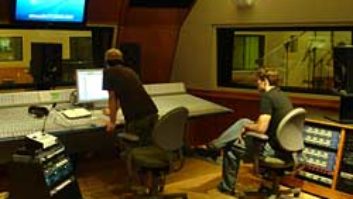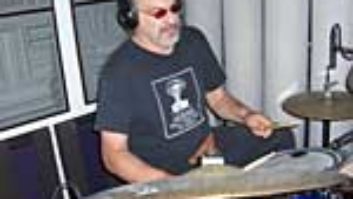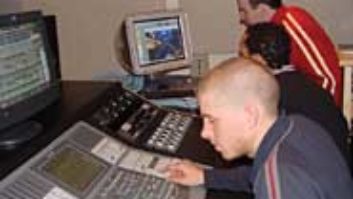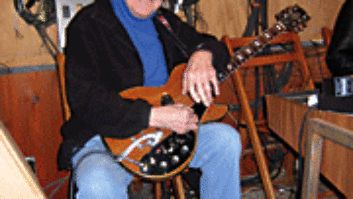DISK-BASED, 24-TRACK RECORDER/EDITOROn October 1, 1992, Tascam unveiled its DA-88 8-track, 16-bit, tape-based MDM, which at $4,499 represented a revolution in the making. Now, eight years later, Tascam is delivering its MX-2424, a disk-based recorder carrying a lower base list price: $3,999. The MX-2424 not only beats the DA-88’s original price, it offers some impressive features. Twenty-four-bit resolution and 24 recording/playback tracks are standard, and the next software release, due this month, will allow the unit to operate as a high-resolution, 12-track/24-bit, 96kHz deck.
Like the DA-88, the MX-2424 is housed in a four-rackspace chassis, and multiple recorders can be locked with single-sample accuracy (1/44,100 sec) if additional tracks are required. However, the MX-2424 makes the DA-88’s feature set seem rather primitive by comparison; the MX-2424 includes onboard MIDI and LTC SMPTE synchronization, standard S/PDIF and AES/EBU digital I/O and outboard control capability via the included ViewNet MX software for Mac or Windows.
Speaking of formats, the MX-2424 will support Broadcast .WAV files on FAT-32 formatted disks in the next software revision. Pro Tools Session file import/export is not currently supported, although the unit can record files in Digidesign’s Sound Designer (SD2) format to a Mac-formatted disk for import into a Pro Tools session. A software upgrade to allow the MX-2424 to import SD2 files directly is slated to be available this month. The MX-2424 also supports TimeLine’s Open Track List (Open TL) format.
Although the MX-2424 has a host of useful record/edit/play/sync features, it should be emphasized that the product is a recorder and has no internal mixing capabilities. The MX-2424 is designed to replace or augment MDMs, analog or digital multitracks or workstations. When operating in its (soon-to-be-implemented) high-res, 24-bit/96kHz, 12-track recording mode, the MX-2424 will be equally at home as a multichannel mixdown deck for storing surround mixes. The 12-track format should be adequate for both a stereo version and 5.1, 7.1 or even 8.1 mixes – and there’ll still be a track or two left for controlling the popcorn machine.
NUTS ‘N’ BOLTSBefore I began working on the MX-2424, I went through the patented George Petersen “let’s-take-it-apart-and-reassemble-it-before-the-session” routine. Popping the top cover, I was impressed by the clean circuit layout. The drive is a 9.1GB Quantum Atlas V, a solid, high-reliability unit that’s mounted in the bay above the open slot for a second internal drive. The user can pick from a list of Tascam-recommended drives, ranging from Travan, DVD-RAM, hard disks (HFS+ support is due later this month) or hot-swappable, removable Kingston carrier frames for drives such as Rhino Jr. or Data Express. Additionally, a rear panel wide-SCSI port is provided for external storage and/or backup devices. Also on the rear panel, two empty slots accommodate a variety of I/O options. The analog option occupies the large slot and has 24 quality AKM 24-bit/96kHz ADCs and DACs (one per channel) built into a heavily shielded card cage terminating in six D25-sub connectors wired in the Tascam DA-88-style pinout. Trying to cram 48 XLRs on the already quite full rear panel would have been impossible, so if you’re planning to use the analog I/Os, you’ll need to put six breakout cables on your shopping list. These are readily available from numerous manufacturers, so there’s no need for costly custom cabling.
Key to the MX-2424’s appeal is its versatility: The large number of available options allows the user to configure the unit to meet most needs precisely. The “core” MX-2424 is priced at $3,999, and the aforementioned analog board costs $1,699. Twenty-four-channel digital I/O cards include the TDIF (three D25-sub ports, $499), the Alesis ADAT (six Lightpipe sockets, $499) and the AES/EBU (three D25-sub connectors, $999). Standard amenities include AES/EBU, and S/PDIF 2-channel digital I/O is routable to/from any stereo track pair. The rear panel also has a punch in/out footswitch jack, MIDI and word clock in/out/thru, TRS balanced LTC SMPTE timecode in/out/thru, a port for attaching the optional $1,499 full-function RC-2424 remote, a TL Bus for cascading multiple MX-2424 decks, video sync in/thru and an RJ-45 Ethernet connector for connecting a personal computer to the MX-2424 for operating the ViewNet application or for loading software upgrades from Tascam’s Web site.
The integrated TL-Bus provides common sample clock and time position signals for multiple Tascam MX-2424 units. Up to 32 MX units (768 tracks!) can be chained together using the TL-Bus sync connector to provide sample-accurate synchronization across all tracks on all machines. The optional TL-Sync stand-alone synchronizer provides a link to DTRS, ADAT and Sony 9-pin serial devices, as well as TimeLine’s Lynx-2 synchronizer modules. Supported frame rates include 30 fps non-drop frame, 30 fps drop frame, 25 fps PAL, 29.97 fps non-drop NTSC and 29.97 fps drop frame, along with pull up/down sample rates.
A large front panel contains the bright, 16-step LED meters for the 24 channels and record-ready and signal-present LEDs for each channel. A clever arrangement of triangular track-select buttons makes track arming fast and easy, and four banks of LEDs show the status of sample rate, timecode, record mode or sync status at a glance. A numeric keypad speeds the entry of locate points, take numbers, EDLs, etc. The transport keys (rwd/ffd/play/stop/record) are like those on any Tascam recorder, a familiar environment for most users. Among the other transport functions are rehearse, autopunch, looping and pre/post-roll functions; an offset function operates on both incoming SMPTE and MIDI sync sources. A front panel slot for a Smart Media flash ROM card simplifies reloading the MX-2424’s operating system for updates from Internet downloads.
A jog wheel offers audio scrub/locate functions. Surrounding the wheel – just a finger’s touch away – are eight function keys (Jog/Scrub mode, Data Up/Down, Nudge/Capture Event, Trim, Setup, Project, and Track View/Unload). Although most basic operations on the MX-2424 are just slightly more complicated than on DA-88, there are also a few operational quirks that had me confused until I got used to the unit’s operation. For example, to enter the menu system in order to set session parameters (such as timecode modes/rates, sampling frequencies, pre/post-roll times, digital/analog input source select, crossfade times, disk utilities, etc.) you simply press the Setup key. However, to select or change a menu item, you must first press the button marked Trim, which I found nonintuitive. After a while, I got used to it, but it could be confusing for the first-time user.
On the subject of navigating the MX-2424, it should be emphasized that most operations are straightforward and logical. However, to make things simpler, Tascam has thoughtfully provided a laminated Quick Reference Guide to typical recording procedures and the 58 menus; additionally, there are a number of useful written addenda to the manual, which are available in PDF form at www.tascam.com. One of these documents is the complete manual for the ViewNet control application, which comes in at 214 pages. Ouch!
While 58 menus may seem formidable, most (such as the all-important front panel LED brightness control) are rarely used and simply scrolled past while getting through to the screen you want. The menu interface is really a lot easier to use than it sounds, and in most cases, once you’ve set your machine up to be the way you want it, all settings can be stored and ready for the next session. Some of the menus are worth exploring for everyday applications – I particularly liked the dynamic display showing the exact number of recording track-minutes remaining on the disk. The disk utilities that have been thoughtfully included – i.e., disk initialization, low-level format, disk cleanup, backup erasure, disk copy status, etc. – are essential tools for preparing for and conducting problem-free sessions.
IN USEOnce the MX-2424 is hooked up and record parameters are set (front panel LEDs confirm recording status at a glance), recording can begin. The unit has a small side-mounted fan that creates some noise, which is noticeable in a quiet control room but less of an annoyance when the unit is rack-mounted. To enter record, you simply arm the required tracks and hold down the Record and Play keys. One-button recording is also an option in the setup menu section.
There is no indication in the two-line, 20-character LCD screen that recording is actually happening – only the lighted Record button LED, the track REC indicator LED and an occasional flash of the status disk light. The only time locator indicator is a line on that same small LCD, so if you’re a fan of a larger time readout, you’ll have to use large display that is part of ViewNet. Alternatively, you could simply hook up a hardware timecode reader to the SMPTE out on the rear panel. The 24 meters are bright, fast 16-LED ladders with a scale that goes as low as -50 dB. Overloads are held until any transport button is pressed, after which they automatically reset.
The MX-2424 is a Tascam product, but the front panel also clearly says “by TimeLine.” This is no surprise, given Tascam’s successful previous partnership with TimeLine on products such as the MMR-8 and MMR-16 digital dubbers. Working on this product, the two companies wisely chose to extend the MMR-8’s lineage, bringing that unit’s disk engine and menu structure to the MX-2424. And in use, the MX-2424 proved to be absolutely rock-solid in the sync department, flawlessly locking to incoming SMPTE and MIDI Machine Control commands.
Besides the usual recorder functions (record/play/locate punch/autopunch), the MX-2424 boasts a variety of editing functions: cut/copy/paste, insert editing, track slipping, wipe/clear and the ability to cut a section while keeping later sections of that track in sync. The user can choose to work in nondestructive (up to 100 levels of undo) or destructive (tape-style) modes. Although limited by the small display, the MX-2424 uses a simple method of clipboard style editing; the desired section is copied to a clipboard and then pasted or inserted into the desired place. Once several edits are made, the track can be “rendered” into a single continuous track, and a project supports up to 999 tracks (24 assigned to outputs and 975 virtual), so multiple takes of solos or vocals can easily be stored and edited into new “perfect” takes. Tascam plans to add waveform view editing into a future version of ViewNet, which should ease the editing process, but for now, the MX-2424 is perfectly capable of handling most studio editing chores, such as moving verses/choruses, vocal comping, etc.
As it exists today, the Tascam MX-2424 is a rock-solid, excellent studio recorder that performs well, sounds great and is priced right. Although it’s not completely finished now – what disk-based recorder ever is – the planned waveform display in ViewNet, expanded file/drive support and 96kHz upgrades make the MX-2424 a versatile studio tool with a bright future.
24/96 MIXING GETS AFFORDABLEAs noted in the Tascam MX-2424 “Field Test,” a new software release allows the unit to operate as a high-resolution 12-track, 24-bit/96kHz deck. To complete the package, Tascam has developed an affordable high-resolution console, the DM-24. Unveiled at the AES show in Los Angeles, Tascam’s DM-24 is a 24-input, 8-bus digital console (or 12×4 operation at 96kHz) that offers full 24-bit performance throughout the signal path. But perhaps the DM-24’s most remarkable feature is its $2,999 price tag.
Despite the affordable price, the DM-24 doesn’t skimp on features. In addition to 16 channels of analog inputs, each provided with an XLR mic and 11/44-inch line input, there are eight additional effects return channels. Each channel has its own programmable compressor and noise gate, digital delay and 4-band parametric EQ, and there are TRS inserts on every channel. Two onboard multieffects processors offer reverb, spatial effects and mic/speaker modeling effects by Tascam, Antares and TC Works. All A/D and D/A converters are 24-bit, and a flexible digital interfacing scheme accepts 24 channels of TDIF I/O, eight channels of ADAT Lightpipe, stereo AES/EBU I/O and two sets of coaxial S/PDIF. Two expansion slots allow for additional analog or digital I/O cards and/or a cascade card to link two DM-24s for 64-channel operation.
Operations are logical. Input channels are switched between two banks of 16 faders. Four rotary controls for EQ (gain/center frequency/Q) and pan use LED ring encoders to indicate positioning. A large LCD screen display flanked by four soft knobs provides control for tweaking aux levels, etc. The surface also includes a jog/shuttle wheel and recorder-style buttons that issue commands to MX-2424s or other MIDI Machine Control-compatible transports.
All console functions are dynamically (or snapshot) automatable, including the 100mm long-throw faders. The automation is built-in – no external computer is required – and up to eight mixes can be stored in the DM-24, with additional storage via MIDI offloads. Once a new mix is opened, the DM-24 automatically enters its automation mode so that any static changes are instantly saved and automation moves from one mixer can control the functions of a cascaded unit.
Initial deliveries of the Tascam DM-24 are planned for early 2001.





